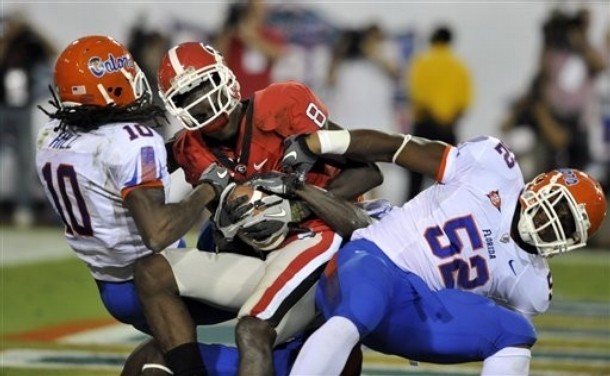Um, uh, ah, er.
It's not easy.
The league boasts a who's who of quarterbacks, running backs, offensive linemen and defenders, and even has a fullback (LSU's Jim Taylor) and a tight end (Alabama's Ozzie Newsome) in the Pro Football Hall of Fame. But when it comes to pass-catchers, the SEC comes up a few yards short.
Sure, Alabama's Don Hutson was the man back in the day. But that was the early 1940s. What about since? Carlos Alvarez? Terry Beasley? Cris Collinsworth? Eric Moulds? Josh Reed? Terrence Edwards? Earl Bennett? All good, but none really special.
The SEC's current crop of receivers could be the best the league has ever offered, with Georgia's A.J. Green, Alabama's Julio Jones, South Carolina's Alshon Jeffery and Kentucky's Randall Cobb leading the way. Throw in Greg Childs and Joe Adams of Arkansas, and the conference has size, speed and arguably more depth at the position than it has in recent years.
"I feel like all of them may go first round when they decide to come out," Green said.
That would be a change.
The SEC had just one first-round receiver, Florida's Percy Harvin, the last three years. Coaches and players insist it's a fluke, pointing out that the NFL's first round in 2007 featured LSU's Dwayne Bowe, Tennessee's Robert Meachem, LSU's Buster Davis and South Carolina's Sidney Rice.
None of those guys has been consistent, adding to the belief that NFL coaches, scouts and general managers have been burned more often than not by SEC wideouts.
Guys like Troy Williamson, Matt Jones, Michael Clayton, Travis Taylor, Marcus Nash and Reidel Anthony are widely considered first-round busts.
"Whether you take receivers from the Big Ten, the SEC or the ACC, there's going to be a number of potential disappointments because of the position," said Jacksonville Jaguars assistant coach Todd Monken, who coached receivers at LSU, Oklahoma State and Louisiana Tech. "It's probably the most volatile position because you're so reliant on others for your success.
"You have to get with the right team, where you're used and you can build confidence and they can build confidence in you. Sometimes that doesn't happen to certain players for whatever reason."
There are plenty of SEC success stories at other positions.
Quarterbacks Bart Starr, Joe Namath, Fran Tarkenton, George Blanda, Charley Trippi played in the SEC, as well as all three Mannings. So did running backs Emmitt Smith, Herschel Walker and Bo Jackson, along with center Dwight Stephenson and guard John Hannah.
Cornerback Champ Bailey, defensive end Jack Youngblood and linebackers Derrick Thomas and Wilber Marshall were dominant in the SEC and the NFL.
But receivers?
Pittsburgh Steelers star Hines Ward, who played quarterback and receiver at Georgia in the 1990s, might be the league's best since Hutson.
Opinions vary on the reason for the gap in greatness. The conference's traditional, run-first mentality might cause some of the top recruits to play elsewhere. Or it could be that college receivers in the South are often guys who played quarterback or running back in high school and take time to develop.
Either way, things are changing.
"If you look at the SEC, for instance, how much it's changed since three or four years ago to now with all the spread offenses and the high-tempo things and things of that nature," Auburn defensive coordinator Ted Roof said. "But that's the transition of college football."
Nowadays, just about every SEC team has that one game-changing receiver. Green and Jones, both juniors expected to be first-round draft picks in April, command constant double teams. And Jeffery, a sophomore whose draft stock will be similar in 2012, is starting to get more attention.
Jeffery leads the league with 932 yards receiving and seven touchdowns. Cobb and Jones aren't far behind. Green would be right up there, too, had it not been for his four-game suspension.
Then there's Tennessee's Denarius Moore, who is averaging a staggering 20.2 yards a catch after his 228-yard performance last week, and Auburn's Darvin Adams, who surely would get more recognition if not for Heisman Trophy front-runner Cam Newton.
"It's a good year to be an offensive fan in the SEC," said Kentucky receivers coach Tee Martin, who led Tennessee to the 1998 national title. "I just think it's a tribute to recruiting and a tribute to the way offenses like to play today."
It's also a blueprint for how SEC teams will recruit and try to play in the future.
"We've got some guys in this league right now that are just putting up some remarkable numbers," Cobb said. "You're getting so many good receivers that can have huge careers because defenses have to stack the box to stop the run. When you have running backs like Mark Ingram, Trent Richardson and Derrick Locke, you've got to find a way to stop them. As an offense you have to have receivers to counter that. ... I think you're starting to see that more in the SEC."

Georgia wide receiver A.J. Green (8) catches a touchdown pass while being defended by Florida safety Will Hill (10) and Florida linebacker Jonathan Bostic (52) during the fourth quarter of an NCAA college football game Saturday, Oct. 30, 2010, in Jac
http://accesswdun.com/article/2010/11/233548
